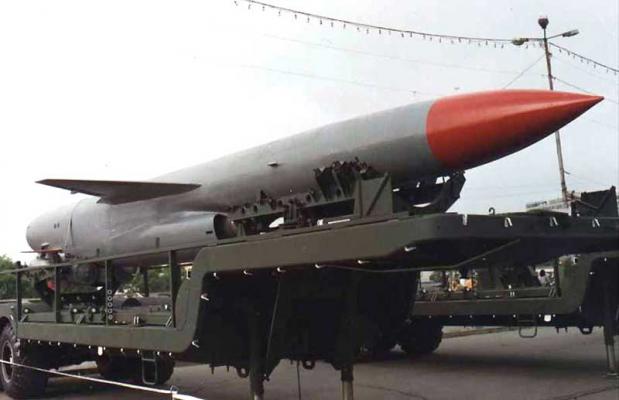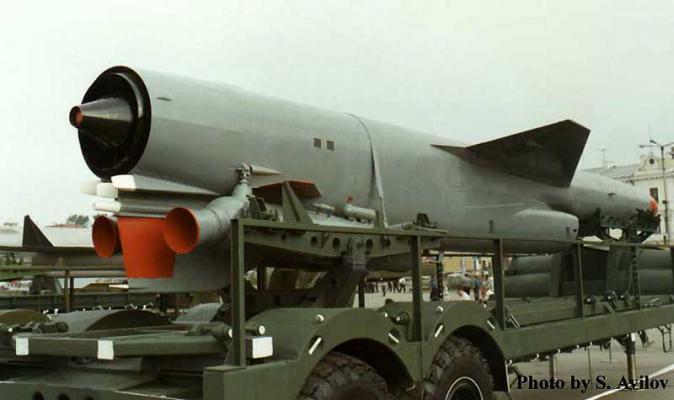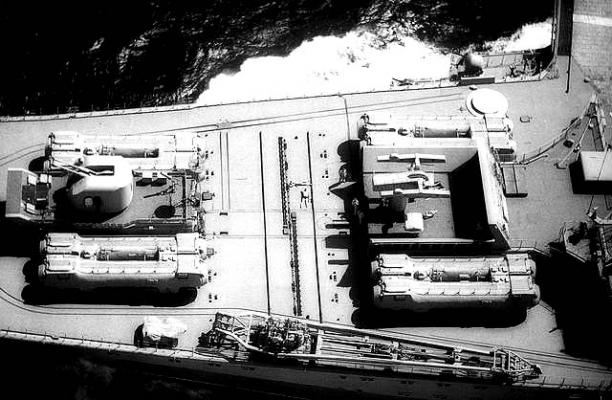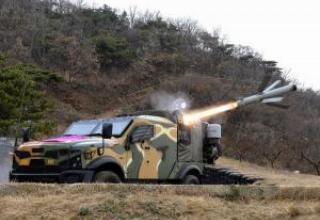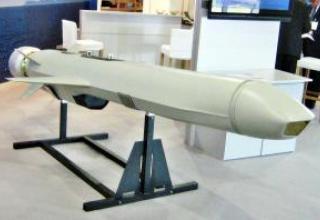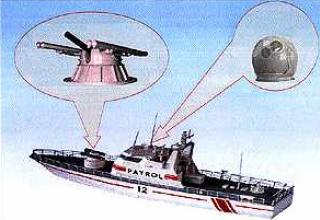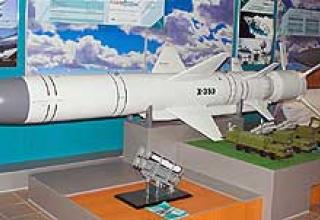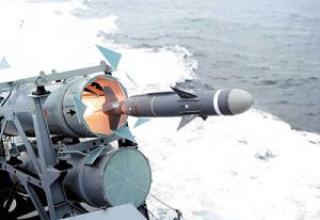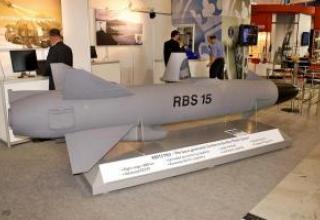На западе ракета получила обозначение SS-N-12 "Sandbox".
The development of the P-500 "Bazalt" anti-ship cruise missile was started by the Design Bureau-52 under Resolution SM No. 250-89 of 28 February 1963. "Bazalt" was designed to combat the most powerful ship groups, including aircraft carriers. It was intended to arm both submarines and surface ships. The Bazalt missile was intended to replace the P-6 missile and had approximately the same weight and dimensions.
The P-500 conceptual design was completed in December 1963.
The first stage of flight and design tests was held from October 1969 to October 1970 in Nenoks. The rocket without radio equipment was launched from the ground stand SM-49.
In 1975, the missile "Bazalt" is adopted for service with nuclear submarines project 675, which were previously armed with a complex P-6. And in 1977, "Bazalt" is adopted for service with aircraft-bearing cruisers such as "Kiev" project 1143. The first three ships of this project had four paired SM-240 launchers each with eight P-500 missiles in containers and eight spare ones in the cellar, and the fourth cruiser, Ave. 1143.4 "Admiral of the Fleet of the Soviet Union Gorshkov" was modernized and had six paired launchers SM-241 with twelve P-500 missiles in containers.
Entry of ships into the Navy was carried out in the following terms: "Kiev" - in December 1975, "Minsk" - in September 1978, "Novorossiysk". - in August 1982, "Admiral of the Navy of the Soviet Union Gorshkov" - in December 1987. The launchers were developed at the Special Machine Building Design Bureau (Leningrad) under the supervision of Chief Designer V.V.Chernetsky.
On the cruisers "Slava" of 1164 project (designer - PKB Severnoe, Chief Designer - A.K.Perkov, since 1979 - V.M.Mutikhin), which went into service in 1982, P-500 missiles were located in sixteen non-permanent containers, without reloading.
In the west, the missile was designated SS-N-12 "Sandbox".
Composition:
"The Bazalt was the last missile to be placed on submarines and launched in the surface position. Like the P-6, the Bazalt missile had a flight profile of "high altitude - low altitude", but unlike the P-6, the length of the final section ("low altitude") was increased and the flight height on this section was reduced.
According to the aerodynamic and structural design scheme, the P-500 was similar to the P-6, but had a higher flight speed, increased range and a more powerful high-explosive combined combat unit designed in the GSCB-47. A nuclear warhead could also be used. The Bazalt missile was the first sea-based cruise missile with high supersonic (up to 2M) flight speed. This had a significant impact on the design. A sub-basement sector air intake with a two-jump central body was developed. Titanium alloys were used in the design of the missile, which have the necessary strength characteristics at elevated temperatures. The study of the structure under the simultaneous effect of force factors of loading and temperature heating was given the utmost attention.
Specially for P-500 there was created a turbojet turbojet engine of increased traction and efficiency KR-17-300 developed in OKB-300 GKAT (see photo of nozzle block).
For the P-500 missile the Central Research Institute "Granit" developed the control system "Argon" (Chief Designer S.I.Chervyakov), which for the first time included the onboard digital computer (BCVM). On P-500 the principle of remote control was preserved, but a more modern control system of increased interference immunity was installed, which allowed to carry out the target distribution of missiles in the volley and selective defeat of the head targets from the attacked ship's connection. For the first time on the PCR was used on-board electronic countermeasures station (active interferences), which affected the GSN ZUR of the enemy and ensured the invulnerability of the CR in the air defense zone of the attacked ship.
Designed to fight against large enemy ship groups, the P-500 was effective only in volley fire, providing its breakthrough through the ABM system. The salvo was formed of 8 missiles at intervals not exceeding 8 seconds. The missile had one major flaw. It had a highly accelerated turbojet turbojet engine, which before the launch had to be put into air launch mode by the air starter directly in the launcher by spinning it up for 20-30 seconds. The rocket was launched and accelerated to cruise speed by two solid propellant boosters. In the case of multiple rocket launches, it was necessary to simultaneously launch the marching engines of all eight missiles in the launchers. When the first rocket was launched, hot powder gases hit the air inlets of the air intakes of the running rocket marching engines. Due to lack of oxygen and high temperature of the gases, the engines were stalled. For the first time this phenomenon was detected on the submarines Prospect 651 and Prospect 675. It could not be dealt with and therefore the submarines Prospect 675 adopted for service had to remove some of the launchers, leaving only the bow and stern launchers far apart. They provided a salvo only for 4 missiles.
The developers of the launcher SM-241 knew about this phenomenon, and, therefore, on the launchers of the first ship of project 1143 provided for a special measurement system as part of pressure and temperature sensors in the necessary areas of the launcher. At the first run tests in the Black Sea phenomenon manifested itself - the launch of the first missile dried engines remaining in the PU missiles. Only after a special program of tests, was determined the order of launching missiles in a volley, which provided a stable volley at intervals of less than 8 seconds. At the same time, there was no need to refine the material part, it was only necessary to refine the software control system.
Research to ensure a stable volley of P-500 missiles, conducted at TAKR "Kyiv", allowed to learn in more detail the cause of the failure of the volley from the launch rocket and gave confidence in the possibility of creating a tight layout of launchers even for such a "naughty" rocket as P-500. This knowledge was required when developing the SM-248 launchers for Project 1164 surface ships. Initially it was planned to place 12 launchers under the TOR, but during the development of the conceptual design it was decided to increase the number of launchers placed on the ship to sixteen, located on board and having individual gas outlets overboard the ship. This arrangement made it possible to dramatically increase the ship's readiness and combat power of a ship capable of producing two successive eight rocket volleys. The design of the SM-248 is based on a fibreglass plastic hull and covers of the launcher. Rocket guides were made of high-strength aluminium alloy B-95 by extrusion without further mechanical processing.
Detection of targets and targeting of the Bazalt complex, as well as the subsequent Volcano and Granite complexes, was carried out using the Marine Space Intelligence and Targeting System (MSC). Full-scale development of the MSC system was initiated in 1962.
Its members were included in the system:
- a radar reconnaissance system to detect surface maritime targets from space;
- a radar reconnaissance system for detecting radiation from space of ship's radio equipment;
- a nuclear power plant that supplies power to space vehicles.
The works on creation of the "Legend" MCC system and its transfer to the USSR Defense Ministry with radar reconnaissance spacecrafts were completed in 1975, and with radar reconnaissance spacecrafts - in 1978.
Later on, a modification of the "Bazalt" complex was created - the 4K80 missile was equipped with a new, more powerful launch vehicle, which increased its range.
Characteristics:
| Range, km | 550 |
| Flight Speed | 2-2.5М |
| The length of the rocket, m | 11.7 |
| Maximum rocket body diameter, m | 0.88 |
| Wingspan, m | 2.1 |
| Start weight, kg | 4800 |
| Weight of combat unit, kg | 500 (according to some sources 1000) |
Testing:
The main elements of the ATACMS system were tested mainly at the White-Sands test site. The system received its baptism of fire in the desert storm. The ATACMS was used to destroy Iraqi army air defense batteries and communications hubs. During the operation, about 200 trucks and equipment were destroyed. The combat effectiveness of these systems has been quite high.
Sources:
- "КБ специального машиностроения: От артиллерийских систем до стартовых комплексов" (под редакцией Ушакова В.С.) .СПб, 2004.
- А.Б.Широкорад "Оружие отечественного флота", Минск, Харвест, 2001г.
- http://www.fas.org
- П-500 "Базальт")
- www.militaryphotos.net
